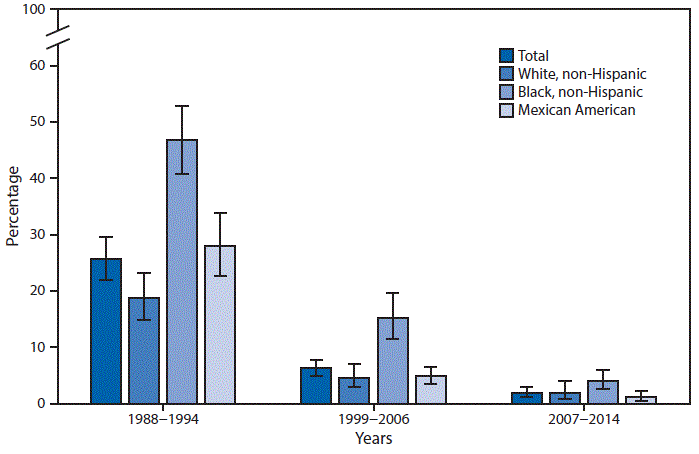 |
| MMWR Weekly Vol. 65, No. 39 October 07, 2016 |
| PDF of this issue |
QuickStats: Percentage* of Children Aged 1–5 Years with Elevated Blood Lead Levels,† by Race/Ethnicity§ — National Health and Nutrition Examination Survey, United States, 1988–1994, 1999–2006, and 2007–2014
Weekly / October 7, 2016 / 65(39);1089

* With 95% confidence intervals represented by error bars.
† CDC currently uses ≥5 µg/dL as a reference level to identify children with elevated blood lead levels (http://www.cdc.gov/nceh/lead/ACCLPP/Final_Document_030712.pdf).
§ Totals include data for racial/ethnic groups not shown separately.
From 1988–1994 to 2007–2014, the percentage of children aged 1–5 years with blood lead levels ≥5 μg/dL declined from 25.6% to 1.9%. Blood lead levels fell dramatically for all racial and ethnic groups. Despite the decline, in 2007–2014, non-Hispanic black children (4.0%) aged 1–5 years were twice as likely as non-Hispanic white children (1.9%) and more than three times as likely as Mexican American children (1.1%) to have elevated blood lead levels.
Source: The National Health and Nutrition Examination Survey; http://www.cdc.gov/nchs/nhanes/index.htm.
Reported by: Sheila J. Franco, sfranco@cdc.gov, 301-458-4331; Kara Koehrn, Environmental Protection Agency, koehrn.kara@epa.gov; Daniel Axelrad, Environmental Protection Agency,axelrad.daniel@epa.gov.





















.jpg)












No hay comentarios:
Publicar un comentario